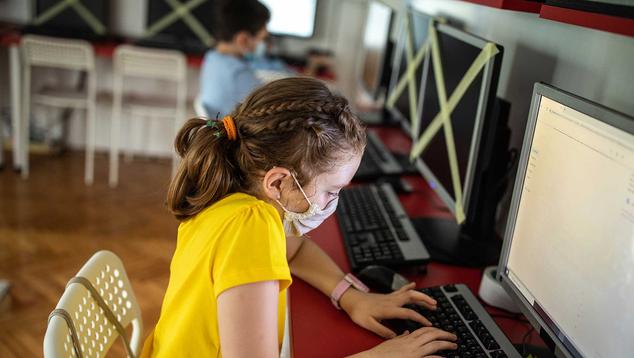As the 2020-2021 school year begins, millions of students across the nation are going back to school virtually, including those in the vast majority of the nation's largest school districts. While the pandemic means decisions are changing rapidly, less than half of all schools in the U.S. are currently planning to return to fully in-person learning this fall.
As education leaders develop and revise plans for the 2020-2021 school year, parents, advocates and educators around the country are rightly concerned with ensuring equity as we navigate an education crisis we've never seen before. In response to these equity concerns, findings from a recent NewSchools Venture Fund-Gallup study provide insights into teachers', parents' and students' perspectives on how teaching and learning occurred in the spring of 2020, their thoughts about the upcoming school year, and the perceived value and effectiveness of digital learning tools to support teaching and learning.
Clarity, Access, Communication Are Keys to Success
The abrupt nature of school closures in the spring of 2020 did not allow for proper planning to transition students and teachers to a fully functional online school environment. Building on the lessons learned from that difficult experience, the study asked respondents to identify the types of educational support they would find most valuable in the upcoming school year.
Of eight potential needs included in the survey, clear expectations for daily or weekly schoolwork is the only one for which broad majorities of teachers (73%), parents (79%) and students (70%) alike agree they need most in the upcoming school year. Having clear expectations for daily or weekly schoolwork is a top need expressed by parents and students among all race/ethnicity groups, grade levels and income levels studied.
Teachers (50%), parents (44%) and students (46%) also say regular access to teachers is necessary for success. Students attending school in a large city (46%) are more likely than those who attend school in a suburb (34%), small town (39%) or rural area (27%) to say they need consistent communication from teachers and school/district leaders.
| Teachers (grades PK-12) | Parents of students (grades PK-12) | Students (grades 3-12) | |||||||||||||||||||||||||||||||||||||||||||||||||||||||||||||||||||||||||||||||||||||||||||||||||
|---|---|---|---|---|---|---|---|---|---|---|---|---|---|---|---|---|---|---|---|---|---|---|---|---|---|---|---|---|---|---|---|---|---|---|---|---|---|---|---|---|---|---|---|---|---|---|---|---|---|---|---|---|---|---|---|---|---|---|---|---|---|---|---|---|---|---|---|---|---|---|---|---|---|---|---|---|---|---|---|---|---|---|---|---|---|---|---|---|---|---|---|---|---|---|---|---|---|---|---|
| % | % | % | |||||||||||||||||||||||||||||||||||||||||||||||||||||||||||||||||||||||||||||||||||||||||||||||||
| Clear expectations for daily/weekly schoolwork | 73 | 79 | 70 | ||||||||||||||||||||||||||||||||||||||||||||||||||||||||||||||||||||||||||||||||||||||||||||||||
| Personal computer or tablet device | 54 | 11 | 13 | ||||||||||||||||||||||||||||||||||||||||||||||||||||||||||||||||||||||||||||||||||||||||||||||||
| Regular access to teachers | 50 | 44 | 46 | ||||||||||||||||||||||||||||||||||||||||||||||||||||||||||||||||||||||||||||||||||||||||||||||||
| Consistent communication from teachers and school/district leaders | 34 | 45 | 37 | ||||||||||||||||||||||||||||||||||||||||||||||||||||||||||||||||||||||||||||||||||||||||||||||||
| Online instructions/resources to help [you/your child] use digital learning tools | 29 | 22 | 23 | ||||||||||||||||||||||||||||||||||||||||||||||||||||||||||||||||||||||||||||||||||||||||||||||||
| Video lessons or video instruction | 19 | 30 | 27 | ||||||||||||||||||||||||||||||||||||||||||||||||||||||||||||||||||||||||||||||||||||||||||||||||
| Digital versions of class materials | 17 | 14 | 24 | ||||||||||||||||||||||||||||||||||||||||||||||||||||||||||||||||||||||||||||||||||||||||||||||||
| Hard-copy materials (like books or worksheets) | 15 | 27 | 23 | ||||||||||||||||||||||||||||||||||||||||||||||||||||||||||||||||||||||||||||||||||||||||||||||||
| NEWSCHOOLS VENTURE FUND/GALLUP, 2020 | |||||||||||||||||||||||||||||||||||||||||||||||||||||||||||||||||||||||||||||||||||||||||||||||||||
Students Need Help Catching Up
About half of all students (46%) say they will need help catching up after remote learning in the spring. Black and Hispanic/Latino students, those from lower-income households with less than $50,000 annually, and high school students are the most likely to say they will need help catching up in the upcoming school year.
| Yes, will need help to catch up | |||||||||||||||||||||||||||||||||||||||||||||||||||||||||||||||||||||||||||||||||||||||||||||||||||
|---|---|---|---|---|---|---|---|---|---|---|---|---|---|---|---|---|---|---|---|---|---|---|---|---|---|---|---|---|---|---|---|---|---|---|---|---|---|---|---|---|---|---|---|---|---|---|---|---|---|---|---|---|---|---|---|---|---|---|---|---|---|---|---|---|---|---|---|---|---|---|---|---|---|---|---|---|---|---|---|---|---|---|---|---|---|---|---|---|---|---|---|---|---|---|---|---|---|---|---|
| % | |||||||||||||||||||||||||||||||||||||||||||||||||||||||||||||||||||||||||||||||||||||||||||||||||||
| All students (grades 3-12) | 46 | ||||||||||||||||||||||||||||||||||||||||||||||||||||||||||||||||||||||||||||||||||||||||||||||||||
| Elementary school (grades 3-5) | 47 | ||||||||||||||||||||||||||||||||||||||||||||||||||||||||||||||||||||||||||||||||||||||||||||||||||
| Middle school (grades 6-8) | 40 | ||||||||||||||||||||||||||||||||||||||||||||||||||||||||||||||||||||||||||||||||||||||||||||||||||
| High school (grades 9-12) | 49 | ||||||||||||||||||||||||||||||||||||||||||||||||||||||||||||||||||||||||||||||||||||||||||||||||||
| Black students | 53 | ||||||||||||||||||||||||||||||||||||||||||||||||||||||||||||||||||||||||||||||||||||||||||||||||||
| Hispanic/Latino students | 48 | ||||||||||||||||||||||||||||||||||||||||||||||||||||||||||||||||||||||||||||||||||||||||||||||||||
| White students | 41 | ||||||||||||||||||||||||||||||||||||||||||||||||||||||||||||||||||||||||||||||||||||||||||||||||||
| Less than $50,000 | 55 | ||||||||||||||||||||||||||||||||||||||||||||||||||||||||||||||||||||||||||||||||||||||||||||||||||
| $50,000 to $74,999 | 52 | ||||||||||||||||||||||||||||||||||||||||||||||||||||||||||||||||||||||||||||||||||||||||||||||||||
| $75,000 to $100,000 | 43 | ||||||||||||||||||||||||||||||||||||||||||||||||||||||||||||||||||||||||||||||||||||||||||||||||||
| More than $100,000 | 41 | ||||||||||||||||||||||||||||||||||||||||||||||||||||||||||||||||||||||||||||||||||||||||||||||||||
| NEWSCHOOLS VENTURE FUND/GALLUP, 2020 | |||||||||||||||||||||||||||||||||||||||||||||||||||||||||||||||||||||||||||||||||||||||||||||||||||
Teachers Value Digital Tools
Most teachers agree (27%) or strongly agree (59%) that there is great value in using digital learning tools. For this study, digital learning tools are broadly described as websites, apps, online tutorials, online games and videos, or programs used to teach and support student learning and schoolwork. These latest results are similar to those in 2019, when 81% of teachers, 88% of principals and 92% of district administrators said the same.
| 2019 | 2020 | ||||||||||||||||||||||||||||||||||||||||||||||||||||||||||||||||||||||||||||||||||||||||||||||||||
|---|---|---|---|---|---|---|---|---|---|---|---|---|---|---|---|---|---|---|---|---|---|---|---|---|---|---|---|---|---|---|---|---|---|---|---|---|---|---|---|---|---|---|---|---|---|---|---|---|---|---|---|---|---|---|---|---|---|---|---|---|---|---|---|---|---|---|---|---|---|---|---|---|---|---|---|---|---|---|---|---|---|---|---|---|---|---|---|---|---|---|---|---|---|---|---|---|---|---|---|
| % | % | ||||||||||||||||||||||||||||||||||||||||||||||||||||||||||||||||||||||||||||||||||||||||||||||||||
| Strongly agree | 51 | 59 | |||||||||||||||||||||||||||||||||||||||||||||||||||||||||||||||||||||||||||||||||||||||||||||||||
| 4 | 30 | 27 | |||||||||||||||||||||||||||||||||||||||||||||||||||||||||||||||||||||||||||||||||||||||||||||||||
| 3 | 15 | 12 | |||||||||||||||||||||||||||||||||||||||||||||||||||||||||||||||||||||||||||||||||||||||||||||||||
| 2 | 3 | 2 | |||||||||||||||||||||||||||||||||||||||||||||||||||||||||||||||||||||||||||||||||||||||||||||||||
| Strongly disagree | 1 | * | |||||||||||||||||||||||||||||||||||||||||||||||||||||||||||||||||||||||||||||||||||||||||||||||||
| * Less than 0.5% | |||||||||||||||||||||||||||||||||||||||||||||||||||||||||||||||||||||||||||||||||||||||||||||||||||
| NewSchools Venture Fund/Gallup | |||||||||||||||||||||||||||||||||||||||||||||||||||||||||||||||||||||||||||||||||||||||||||||||||||
While teachers see great value in digital tools, they are less likely now than they were in 2019 to indicate digital tools are at least as effective as nondigital tools. For example, while 63% of teachers in 2019 said digital learning tools are more effective than nondigital tools for connecting learning to students' future jobs and careers, 48% now say the same.
Still, the current findings show that majorities of teachers say digital learning tools are either equally or more effective than nondigital tools for nine different areas surveyed, including personalizing instruction (87%), giving students ownership of their learning (85%), and engaging students with school and learning (76%).
Enthusiasm for Digital Tools Has Waned
Students are less likely now than they were in 2019 to say digital tools are fun and make school more interesting. Nearly all younger students said in 2019 that digital learning tools are fun (96%), while 78% say the same in 2020. Older students' perspectives have also shifted. Less than half of students in grades six through 12 now agree that digital learning tools are fun (36%), make school more interesting (43%), help them learn things faster (39%) and help them remember what they learn (41%).
| Younger students (grades 3-5) | Older students (grades 6-12) | ||||||||||||||||||||||||||||||||||||||||||||||||||||||||||||||||||||||||||||||||||||||||||||||||||
|---|---|---|---|---|---|---|---|---|---|---|---|---|---|---|---|---|---|---|---|---|---|---|---|---|---|---|---|---|---|---|---|---|---|---|---|---|---|---|---|---|---|---|---|---|---|---|---|---|---|---|---|---|---|---|---|---|---|---|---|---|---|---|---|---|---|---|---|---|---|---|---|---|---|---|---|---|---|---|---|---|---|---|---|---|---|---|---|---|---|---|---|---|---|---|---|---|---|---|---|
| % Yes | % Yes | % Strongly agree/Agree | % Strongly agree/Agree | ||||||||||||||||||||||||||||||||||||||||||||||||||||||||||||||||||||||||||||||||||||||||||||||||
| 2019 | 2020 | 2019 | 2020 | ||||||||||||||||||||||||||||||||||||||||||||||||||||||||||||||||||||||||||||||||||||||||||||||||
| They are fun. | 96 | 78 | 61 | 36 | |||||||||||||||||||||||||||||||||||||||||||||||||||||||||||||||||||||||||||||||||||||||||||||||
| They make school more interesting. | 86 | 60 | 67 | 43 | |||||||||||||||||||||||||||||||||||||||||||||||||||||||||||||||||||||||||||||||||||||||||||||||
| They help me learn things faster. | 77 | 54 | 55 | 39 | |||||||||||||||||||||||||||||||||||||||||||||||||||||||||||||||||||||||||||||||||||||||||||||||
| They help me remember what I learn in class. | 82 | 75 | 57 | 41 | |||||||||||||||||||||||||||||||||||||||||||||||||||||||||||||||||||||||||||||||||||||||||||||||
| NewSchoolS Venture Fund/Gallup | |||||||||||||||||||||||||||||||||||||||||||||||||||||||||||||||||||||||||||||||||||||||||||||||||||
Implications
Many K-12 districts are entering the school year fully online, or in person with an expectation that remote learning will become required at some point during the 2020-2021 academic year due to the COVID-19 pandemic. For all of these schools, digital learning tools are core to how they will reach and teach students during this incredibly difficult school year, and results from this study indicate that students' experience in the spring of 2020 may have negatively impacted their attitudes toward digital learning tools.
Despite some difficulties in the spring of 2020, though, teachers still see the potential value in these tools. Ensuring teachers have sufficient support will be critical to success in this upcoming year -- from digital learning tool providers and their school districts -- to maximize these tools and help students who fear they have fallen behind catch up and get ahead during a tumultuous academic year ahead.
In addition to the effective use of digital learning tools, it is important to note the main things all parties say they need to be successful this coming school year: clear expectations, access to teachers and consistent communication. The present reality -- one in which teachers, parents and students differ significantly in their confidence in and expectations for this fall -- indicates that these things are in short supply.
As we navigate this fall, schools will need to work to understand where parents and teachers are coming from, and address expectation gaps and confusion swiftly and intentionally. Perhaps more than ever, having teachers, parents and students well-connected and aligned is going to be crucial as families navigate distance learning and many use digital learning tools in new or different ways. There is an urgent opportunity for this improved coordination and collaboration if we are to provide more equitable learning outcomes for our students. While digital learning tools are well-positioned to support this effort, it will be the expectations and practices we put in place that determine our success.




